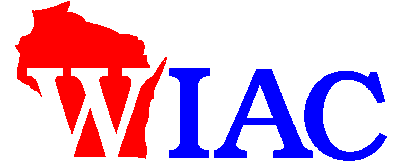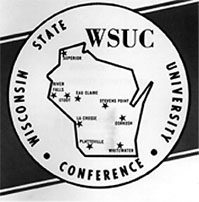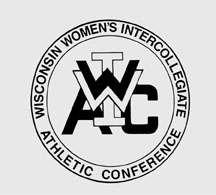![]()

The Wisconsin Intercollegiate Athletic Conference (WIAC) was formed on July 1, 1997, when the Wisconsin State University Conference (WSUC) and the Wisconsin Women's Intercollegiate Athletic Conference (WWIAC) merged together. The NCAA Division III Conference league consists of nine schools: Eau Claire, Oshkosh, Platteville, River Falls, Stevens Point, Stout, Superior, and Whitewater. The first appointed commissioner was Dr. Gary F. Karner, with Judy Kruckman as the assistant sports information director.
 .
.
In 1920, the Girls Athletic Association (GAA) was organized at the University of Wisconsin Oshkosh, then known as Oshkosh Normal School, to create interest in athletics and promote good fellowship among the women on campus. Field hockey, baseball, basketball, tennis, and hiking were some of the sports offered for the women to participate in. The GAA later changed its name to the Women's Athletic Association (WAA) in 1937. Under the direction of Miss Cecill Barnette, a new physical education instructor, the WAA's emphasis was placed on the development of skill and recreational games to use later in life. Programs offered included basketball, field hockey, volleyball, baseball, archery, golf, tennis, badminton, and campfire girls. In 1947, the WAA soon become the Women's Recreation Association (WRA). The purpose of the program was to provide women the free opportunity to participate in organized athletic and recreational activities without having to pay an activity fee. Sports included in the WRA were bowling, recreational and competitive swimming, modern dance, fencing, tennis, gymnastics, softball, track, hockey, golf, basketball, badminton and volleyball, which were conducted on intramural and extramural levels.

In 1958, the Wisconsin Athletic and Recreation Federation of College Women (WARFCW) was formed for the purpose of coordinating athletic activity among Wisconsin institutes for higher education, with the responsibility of governance placed primarily on the students. Schools participating in the WARFCW conference were Eau Claire State College, La Crosse State College, UW-Milwaukee, Oshkosh State College, Platteville State College, Ripon College, River Falls State College, and UW-Madison. The WARFCW consisted of archery, badminton, basketball, golf, gymnastics, tennis, and volleyball. In 1966, the first motion to form a conference was denied, but in 1969 a state meet for each sport was constituted. By investigating Minnesota's intercollegiate athletic organization for women, an agreement was made in 1970 that a development of a conference was appropriate. In January of 1971, the reality of the WWIAC was developed and consisted of twelve members, consisting of the previous nine and adding Carthage College, UW-Madison, and UW-Parkside, reaching a maximum of 16 members in 1975. A committee made up of two representatives from Whitewater, as well as one representative from Superior, Stevens Point, and Oshkosh, wrote a constitution. Representing Oshkosh was Helen Briwa, who participated in the WARFCW bi-annual meetings to discuss issues within the conference.
All of these schools were affiliated with the Association of Intercollegiate Athletics for Women (AIAW) and the Midwest Association of Intercollegiate Athletics for Women (MAIAW) at one point in time. In 1982, the AIAW dissolved and members became affiliated with either the National Association of Intercollegiate Athletics (NAIA) or the National Collegiate Athletic Association (NCAA), of which the University of Wisconsin Oshkosh is currently a member.
With the implementation of Title IX, the WWIAC had the ability to establish the support and credibility to transform women's sports into what it is today.
Facts about the WIAC
- The WIAC competes
at the NCAA Division III level.
- Student athletes
compete without the benefit of athletic aid or scholarships.
- Approximately 4,000 student athletes compete each year in the WIAC.
Briwa, Helen. H. (1999). Personal interview.
Quivers. (1920, 1937 & 1947). University of Wisconsin Oshkosh.
Wisconsin Intercollegiate Athletic Conference Directory and Records Book. (1998 - 1999). 4 - 6.
Wisconsin Intercollegiate Athletic Conference Homepage {On-Line}. (1999). Available: www.uwsa.edu/wiac.
